
In this section, we begin the survey of the Trojan War, the greatest conflict of the mythical age. Although archaeologists have determined that there was in fact an assault against Troy by the Greeks about 1220 B.C., the version related by storytellers such as Homer transformed the battle to one of mythical proportions.
This section focuses on the beginning of the war, from the ultimate origin up the point just before the final assault, which is covered in the next and final section, Section 12.
Contents
In the kingdom of Sparta the ruler was Tyndareus, whose wife was the beautiful queen Leda. She was yet one more mortal woman to whom Zeus was attracted, and he visitied her this time in the form of a swan. The first image below is a white-ground vase painting from the Classical period wih Leda seen here riding on the back of the swan, followed by a Renaissance version by Antonio da Correggio (1489-1534).

White-ground
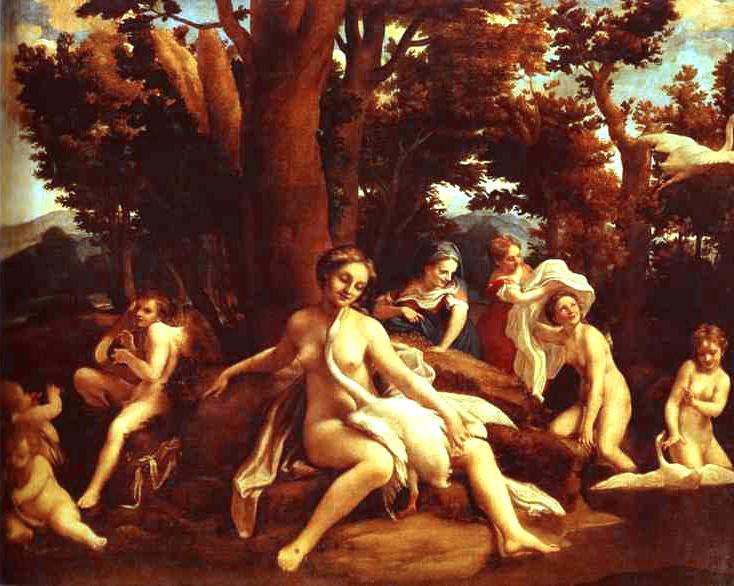
Correggio
The third painting is a watercolor by Gustave Moreau (1826-1898), done about 1880, which is noted for one special reason, for it was the inspiration for this poem written in 1928 by William Butler Yeats (1865-1939), one of the most noted poets of the time. The poem, just as the painting, is primarily an erotic description of their lovemaking, yet lurking in the future because of this act of love is the death and destruction of the war.
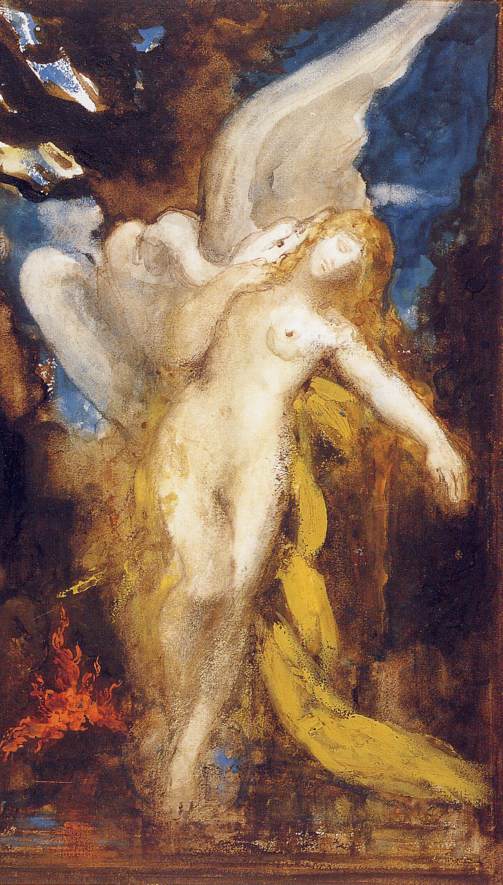
Moreau
A sudden blow: the great wings beating still
Above the staggering girl, her thighs caressed
By the dark webs, her nape caught in his bill,
He holds her helpless breast upon his breast.
How can those terrified vague fingers push
The feathered glory from her loosening thighs?
And how can body, laid in that white rush,
But feel the strange heart beating where it lies?
A shudder in the loins engenders there
The broken wall, the burning roof and tower
And Agamemnon dead.Being so caught up,
So mastered by the brute blood of the air,
Did she put on his knowledge with his power
Before the indifferent beak could let her drop?
Then the painting "Leda Atomica" from 1949 by surrealist Salvador Dali (19-4-1989), known for his bizarre works combining unusual imagery. Here Dali certainly intended to parody the idea of a human woman mating with a swan.

Salvador Dali
The two best-known artists of the Italian Renaissance have something in common, for both of these master artists produced during their life a painted version of Leda and the Swan, yet neither of their original works exists anymore. Their existence is shown only through the evidence of drawings and copies of them by other artists, as seen below.
The first image is a pair of pages from the sketchbooks of Leonardo (1452-1519), practicing Leda's elaborate hairstyle, followed by two paintings which are copies, made by later followers of his and reproducing the master's painted version. Although some of the details differ, they convey the essential appearance of Leonardo's lost original, (done about 1508) which apparently included either two or four of the couple's offspring, hatched from eggs.
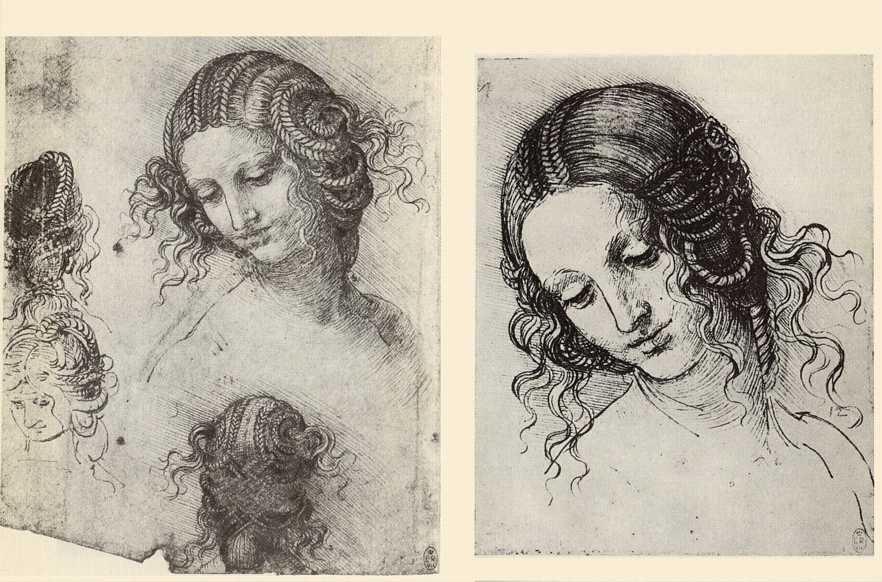
da Vinci

da Vinci Copy 1

da Vinci Copy 2
A few decades later (about 1530), Michelangelo (1475-1564) did his version, much more erotic than Leonardo's. Here Leda and the swan are embracing closely, the moment of conception of their children. The first copy here is anonymous, followed by a marble version by Jacopo Sansovino (1486-1570), and a third copy by Peter Paul Rubens (1577-1640).

Michelangelo

Sansovino

Rubens
The connection between this story and the Trojan War is that one of the children engendered by this couple was the beautiful Helen of Sparta, the woman who later sparked the war, as described below. The other children were Clytemnestra (whose story is covered in Trojan War II), while their two brothers were Castor and Polydeuces, known as the Dioskouroi, or the Gemini twins.
Thetis was a Nereid, a daughter of Nereus the sea-god. Zeus had been attracted to her, but he learned of a prophecy that she was destined to bear a son who would be greater than his father, so it was arranged that she become the bride of a mortal man named Peleus. But in order to win her as bride, Peleus had to first pass the challenge of defeating her in a wrestling match, made difficult because of her power to transform her body into various shapes, as depicted on the red-figure vase painting here.

Red Figure
She eventually submitted, and their wedding celebration was one of the greatest in all Greek mythology. This was the subject of the central register of the Francois vase (see Oedipus article for the Calydonian Boar Hunt), although much of this portion was damaged by a deranged man who attacked it in the museum.
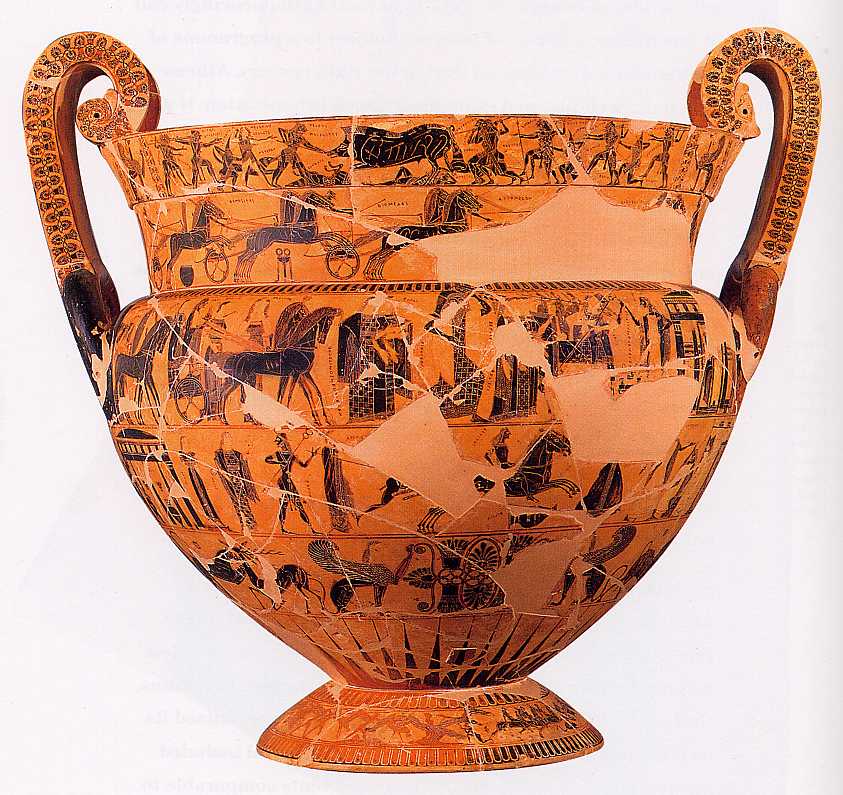
Francois
The drawing below shows the wedding scene, with the part in the photo along the bottom, and the other side seen along the top, with the Greek names rewritten in English.

Facsimile Francois Vase
In the lower left are the wedding couple, Thetis modestly inside a building while Peleus greets the guests. The first to arrive is Chiron the centaur.
The detail photo below is from a different but similar vase painted by the Sophilos artist, showing Chiron and Hebe, the goddess of youthful beauty, then Dionysus and Leto.

Sophilos
Another version by Joachim Wtewael (1566-1638), dated to about 1615, shows the wedding party. Notice that the bride, Thetis, is colored blue, since she is a goddess of the sea.

Wtewael (1615)
However, one goddess had been excluded from the guest list: Eris (a name meaning "discord" or "strife"). She decided to come anyway, to ruin the party. Eris is seen by herself labelled on an ancient vase painting, and can also be seen on the far right of the painting of the wedding by Edward Burne-Jones (1833-1898). Eris produced a golden apple at this party, which had the words "for the fairest" inscribed on it. This caused the goddesses to begin quarrelling with one another over who was the most beautiful, spoiling the celebration.

Eris

Burne-Jones
Zeus then decreed that this quarrel over the golden apple was to be settled by a mortal man named Paris, living the life of a shepherd at that time, and unaware that his true parents were the rulers of the mighty city of Troy. So one day, literally out of the blue, Hermes came to Paris, who was tending his flocks, and gave him the golden apple along with Zeus' instructions to decide which goddess would get it. He had to choose between Hera, Zeus' wife, Athena, the warrior goddess, and Aphrodite, the goddess of love, beauty and sex.
This has long been one of the most popular subjects of artists all through history. The versions seen here a just a small sampling of the hundreds in existence. It is in a way the ultimate male fantasy (and most artists in history were male) to depict the three most beautiful females of mythology, often shown undresssing to display themselves to Paris.
The first version here is a red-figure vase, with all five principal characters: the two males, Paris and Hermes, and the three females, Hera, Athena and Aphrodite, as do all the other versions seen here. The second is an eroded relief from a Roman amphitheater, but each is still recognizable.

Red Figure

Roman
The third is from the Renaissance, by German artist Lucas Cranach (1508), then the versions by Hendrick Van Balen and Wtewael, both about 1600, while Rubens' is from 1635 and Jean-Antoine Watteau's painting dates to about 1715.

Cranach (1508)

Van Balen (c. 1600)

Wtewael (c. 1600)

Rubens (1635)

Watteau (1715)
Paris awarded the golden apple to Aphrodite, largely because of the offer she had made to to influence his decision, that if he chose her, she would compel the most beautiful woman in the world to fall in love with him. True to her promise, Paris was promised the love of Helen of Sparta, at that time the wife of Menelaus.
Because of Aphrodite's power, Helen would do whatever Paris wanted, thus when he arrived at Sparta, he soon persuaded her to leave her husband and return with him to Troy, which she did. The scene of Paris wooing Helen is the subject of this painting by Jacques-Louis David (1748-1825), from 1788.

Jacques-Louis David (1788)
Following is that of Richard Westall (1765-1836), which includes Aphrodite in the background. This is actually based on a later part of the story.

The Reconciliation of Paris and Helen - Westall (1765)
Another popular subject is Helen by herself: these paintings, all from the late 1800s, are portraits of her, the artists' effort to capture the ultimate beauty of the ideal woman, but along with her comes the cost of the death and destruction of Troy. The first is by Evelyn De Morgan (1855-1919), the second by Frederick Leighton (1830-1896), and a watercolor by Gustave Moreau.

Evelyn De Morgan

Frederick Leighton

Gustave Moreau
The son of the couple at whose wedding the trouble started was named Achilles, and he was destined to play a major role in the Trojan War. But there are some noteworthy stories of his life before the war began: first is the scene by Rubens showing the popular legend that his mother Thetis dipped him into the river Styx, which made him invulnerable to harm, except for the spot on his heel where she held him, hence the term 'Achilles' heel'. (But not all ancient sources use this idea. It is not found in the works of Homer).

Rubens
As a child, Achilles was put into the care of Chiron the centaur, just as Jason had been, seen in the previous section. The second image here is a combined view of both sides of a black-figure vase showing his father Peleus giving him to Chiron. Next is a wall painting from Pompeii with Chiron giving young Achilles a music lesson, and then a ceiling panel by Eugene Delacroix (1798-1863) with young Achilles riding on Chiron's back.

Black Figure

Pompeii

Delacroix
The last three images here refer to Achilles' life on the island of Scyros, where he dressed and lived a girl among girls. This was because his mother Thetis had some knowledge of the future and knew he would die young if he joined the war, and had hidden him there to prevent that from happening.
But the Greeks were suspicious, for they had reason to believe Achilles was there somewhere among the girls of Scyros, and Odysseus devised a way to expose him. A chest of gifts was offered to the young ladies, but included among the feminine things was a set of armor and weapons. The Greeks noticed how one 'girl' was fascinated by only those items, and thus Achilles' disguise was exposed. The scene appears below, first in a wall painting from Pompeii, then in a painting by Nicolas Poussin (1594-1665), and one more by Gerard de Lairesse (1641-1711).

Pompeii

Poussin (1656)

Lairesse (1685)
After she left with Paris, Helen's husband Menelaus turned to his brother Agamemnon, the powerful ruler of Mycenae (which in history was one of the major cities of Bronze-Age Greece). Agamemnon then ordered all the cities and regions of Greece to supply men and ships for a mass attack against Troy unless Helen was returned.
The place for the rendezvous was a small coastal city called Aulis, and it was there that Agamemnon incurred the wrath of the goddess Artemis by killing one of her sacred deer. The angry goddess would not allow the proper winds to blow to sail to Troy unless Agamemnon was punished by sacrificing his own daughter Iphigeneia. Reluctantly, Agamemnon sent to Mycenae for Iphigeneia to come to Aulis, but only after her arrival did she discover the real reason she had been summoned there.
The first image below is a wall painting from Pompeii, with Agamemnon shrouding his head in shame for what he is allowing to be done, while Iphigeneia pleads to her father. But this painting also includes a scene of the miraculous rescue of Iphigeneia, for some say Artemis had pity on her and magically whisked her away, as shown here riding the back of a deer. (Or some say by substituting the deer in her place.)

Pompeii
The same scene appears in the next two paintings by Giovanni Battista Tiepolo (1696-1770), the first in 1757, then again in 1770.

Giovanni Battista Tiepolo (1757)

Giovanni Battista Tiepolo (1770)
The Greeks sailed to Troy, but the Trojans refused to return Helen, and thus the war was on. But Troy was so well defended that the Greeks could only surround the city and wear the Trojans down slowly with a siege. This stalemate lasted into the tenth year, until a day came when an event occurred which no one suspected would lead to the end of the Trojan War.
This is the part of the story covered by Homer in his epic poem the Iliad, the oldest work of literature in Western civilization. The key event at the beginning of the first chapter tells of Achilles' anger at Agamemnon, resulting from an argument over a captive girl named Briseis.
Their quarrel is shown here in the painting by Tiepolo: Achilles has begun to draw his sword to attack Agamemnon (on the left), but the goddess Athena has suddenly appeared to stop Achilles, gripping him by the hair and telling him to restrain his anger. Achilles obeyed the goddess, but announced that he would no longer fight for Agamemnon. After his withdrawl, the Greeks redoubled their efforts, but gradually the advantage went to the Trojans.

Tiepolo
The only Greek hero who succeeded in the absence of Achilles was Diomedes, who almost killed Aeneas, and actually wounded Aeneas' mother, Aphrodite, who had come to save her son, as seen here in the painting by Ingres.
Ingres
Ingres also painted the scene called the 'Embassy to Achilles.' After Agamemnon regretted losing Achilles, he sent three of his closest friends (Odysseus, Phoenix and Ajax) to try to persude him to return, but Achilles was relaxing in his tent with his friend Patroclus and told the three to inform Agamemnon he would not be returning to the war. But the battle grew serious, and to rally the endangered Greeks, Achilles allowed his friend Patroclus to wear his armor into battle.

Embassy
But Patroclus was killed by Hector while wearing Achilles' armor. The black-figure cup seen here shows the scene in two parts, on either side, with Patroclus dead in the upper view, while the view below shows him naked after Hector has stripped the armor for himself.

Black Figure
The last image here is the copy of a Hellenistic sculpture with Menelaus holding the dead body of Patroclus. The place of origin and the artist are unknown. The piece now stands in the Loggia della Lanzi in Florence, near Cellini's Perseus (shown in Underworld).

Menelaus
Achilles was devastated by his friend's death. In the painting here by Fuseli, we see him being tormented by the ghost of Patroclus.

Fuseli
Achilles then renounced his vow and returned to the war, to punish Hector for killing Patroclus. But since Hector now possessed his armor, he would need a new set, so his mother Thetis went to the workshop of Hephaestus, as seen here in this damaged wall painting from Pompeii.

Pompeii
Agamemnon was glad to have Achilles back and showered him with rewards, including the return of Briseis, the girl who had been taken from him after their initial argument. Rubens depicted this scene, as well as the final battle of Achilles and Hector. But after killing him, Achilles was still enraged, and abused the body of Hector by dragging it behind his chariot around the walls of Troy.

Rubens

Rubens
The red-figure vase painting here by the Brygos painter shows Hector's father Priam, the king of Troy, who has come to the tent of Achilles to beg for the return of his son's body. Achilles initially ignored his request, as seen here, not even looking at Priam (note also the corpse of Hector on the ground below). But finally, out of pity he released his anger and allowed Priam to take the body back to Troy for burial, the concluding scene of the Iliad. The fall of Troy was inevitable now that Hector was dead.

Brygos painter
Other poets after Homer filled in the details of what happened after the events of the Iliad. Shortly thereafter, a contingent of Amazons arrived, from the race of female warriors who were allies of the Trojans. Their leader, Penthesilea, engaged in battle with Achilles, who slew her. However, the story says that even as they fought, their eyes met in a momentary spark of romance. But alas, fate had made it impossible.
This scene appears on the black-figure vase painting by the artist Exekias, considered one of the greatest artists of the Archaic period, working about 540-530 B.C.

Exekias
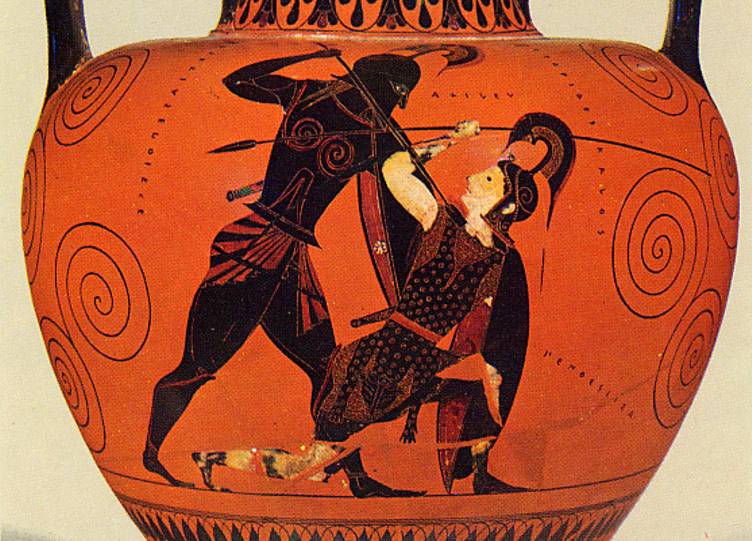
Detail
Another vase by Exekias features Achilles, depicting not a major part of the story, but rather a quiet moment with Achilles enjoying a board-game with his friend Ajax.

Game

Detail
Achilles himself did not live to see the end of the war, for shortly before that, he was ambushed and shot with a poisoned arrow by Paris, as seen here in the painting by Rubens.

Rubens
The small detail from the handle of the Francois vase shows Ajax carrying the stripped corpse of his friend Achilles.

Francois
After his death, there was disagreement among the other Greeks over who should inherit the arms and armor of Achilles, since this would be an acknowledgement of being the greatest warrior after Achilles. The dispute came down to two contenders: Odysseus and Ajax. When the decision went to Odysseus, Ajax went insane with rage, so humilated that he chose suicide as his only way out. Exekias captured the moment of his decision in this black-figure vase painting, the grim moment when he has made up his mind to take his life by falling upon his own sword.

Exekias

Detail
Contrast Exekias' version with the red-figure vase below, perhaps more explicit, but less artistically effective.

Red Figure